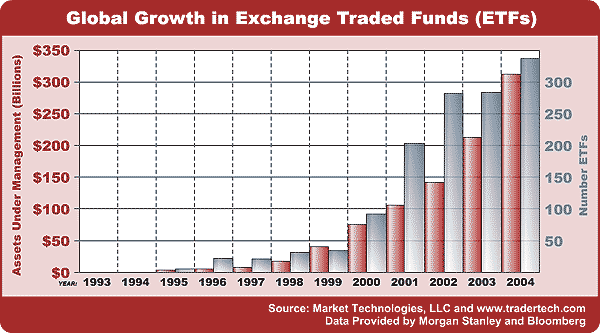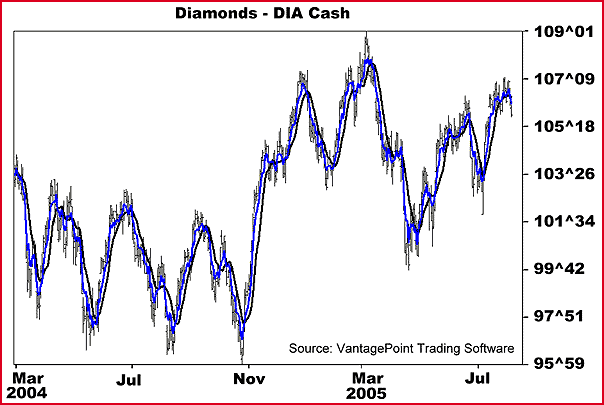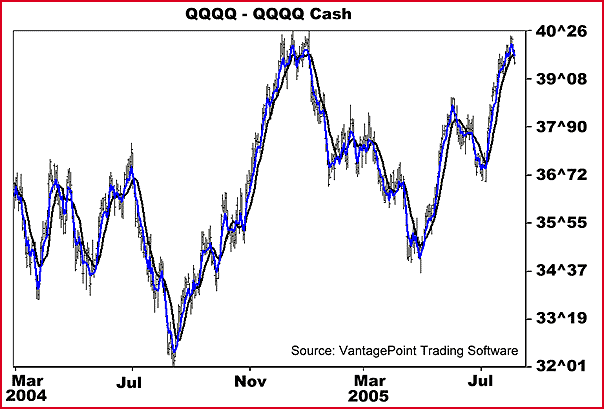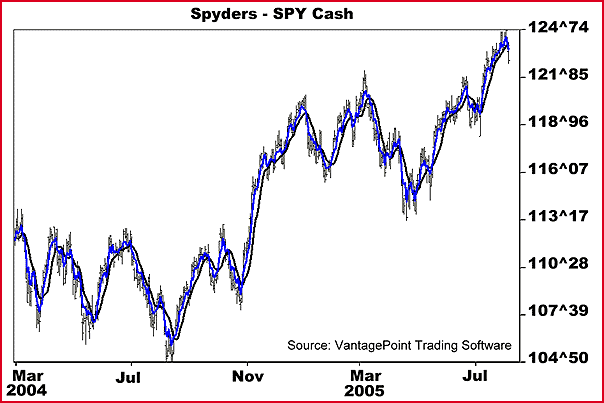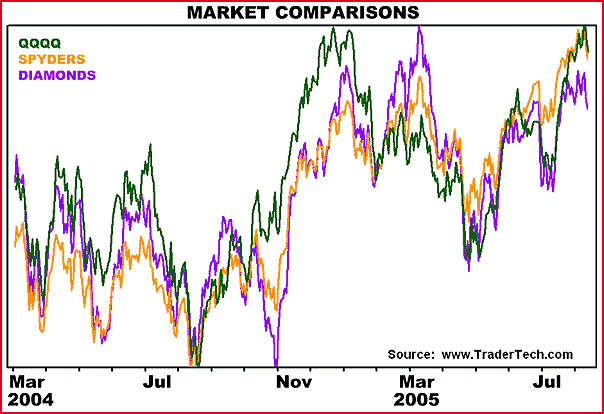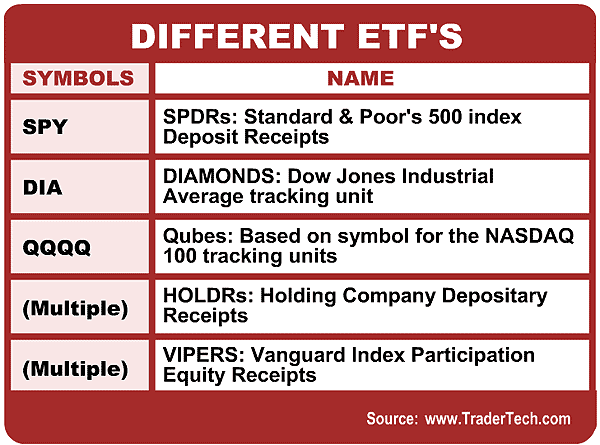
HOT TOPICS LIST
- Strategies
- Stocks
- Buy
- Investing
- Brokers
- Psychology
- Interviews
- Accumulate
- Sell
- Hold
- Spotlight
- Websites
- Candlestick Corner
- Gold & Metals
- Options Trading
LIST OF TOPICS
TRADER'S NOTEBOOK
Using Intermarket Analysis With Exchange Traded Funds
08/04/17 02:00:32 PM PSTby Matt Blackman
Previously, Matt Blackman explained how using intermarket analysis can help traders survive the rocky waters of today's market. This time, he suggests using intermarket analysis with exchange traded funds and gain another advantage.
| Intermarket analysis describes the impact that different asset classes and global markets exert upon one another. This topic has been discussed in numerous trading books and articles, and says, in a nutshell, that all global markets and asset classes are interconnected. Although these relationships vary from market to market and change over time, they cannot be ignored. I discussed this topic in my last article, "The Market Thrivor's Secret Weapon." How does intermarket analysis work with, say, exchange traded funds (ETFs)? It must work well, because the advantages of applying intermarket analysis to ETFs have not escaped industry players like Darrell Jobman, senior market analyst for TraderTech.com. According to Jobman: "ETFs trade like stocks, giving investors an instrument with which they are familiar to trade a broader equity market and allowing them to emulate professional fund managers without having to pay management fees. Combining an ETF with the use of intermarket analysis allows the trader, no matter how small, to mimic what the institutions are doing with the latest state-of-the-art trading signals without having to pay the high fees traditionally associated with this level of sophistication." And as Louis Mendelsohn, developer of VantagePoint Intermarket Analysis Software, CEO of Market Technologies, and author, commented, "As members of the stock index family, ETFs are heavily influenced by what is happening in other markets and frequently provide good trending situations, making them perfect candidates for intermarket analysis by the technical trader with the right technology." So it sounds as if the two work well together. Like intermarket analysis, it feels as though exchange traded funds (ETFs) have been around forever, largely due to their tremendous growth since their introduction in 1993 (see Figure 1). They grew more than 46% in dollar asset terms between 2003 and 2004 alone, and there is little evidence this incredible rate of growth will slow anytime soon.
Figure 1: GLOBAL GROWTH IN EXCHANGE TRADED FUNDS. Chart showing the growth in ETFs from three ETFs with $811 million in assets under management in 1993 growing more than 300 fold to 336 ETFs worth $309.8 billion in 2005. (Market Technologies, LLC; data provided by Morgan Stanley and Bloomberg)
Why so popular? What are they, anyway? Basically, ETFs are index mutual funds that trade like stocks, offering the additional opportunity to buy baskets of stocks. Like stocks, ETFs involve lower fees and have no restrictions on how often they can be bought and sold. With mutual fund restrictions and minimum holding periods in place, this is a huge consideration. There are many benefits to using ETFs in favor of mutual funds, particularly in terms of commissions; commissions for ETFs are the same as for stocks when using a discount broker -- that is to say, negligible. "TO THE MOON, ALICE..." Between 2003 and 2004, ETF assets worldwide increased 46.1%. Assets increased 51.1% in the US, 66.5% in Europe, and 9.7% in Japan. Since 1993, US ETF assets have grown from $460 million to more than $227 billion, an average growth rate of nearly 50% per year. ETF ADVANTAGES
Grahame Lyons of Barclays Global Investors considers it the task of the ETF marketmaker/specialist to match supply with public demand and increase the number of ETF shares as demand warrants. Barclays is the advisor of the iShares ETFs in the US and works closely with the specialists of each iShare to facilitate market liquidity. When demand spikes, the specialist places an order with the ETF advisor that creates more ETF shares to facilitate purchase at or very close to the fund's net asset value (NAV). According to Lyons, if the client wishes to sell and there is no matching buyer, the advisor acts upon the specialist's direction and redeems the ETF shares at NAV. This is one big reason why exchange traded funds have become such a popular vehicle for institutions and professional money managers. Slippage due to spreads is substantially reduced, and no matter how big a block of shares the client needs, the sale will be accommodated without seriously affecting value. In addition, there is less risk of getting stuck holding a large position if the market starts to move in the wrong direction.
DIAMOND, QUBES, SPYDERS The daily charts of these three major index ETFs can be seen in Figures 2 through 5, showing the simple 10-day simple moving average (SMA, black line) with the 10-day predictive moving average (PMA, blue line), based on inputs from nine other related markets. Figure 2 is a daily chart of the DIA, which shows the PMA based on the intermarket effect of nine other markets, including the Dow Jones Utilities Average, the NASDAQ 100 index, the S&P 500, the CRB index, and the US dollar index. PMA's goal is to give the trader advance warning of a change in direction. Instead of lagging the market, it leads it. This technique works equally well for SPY and QQQQ.
Figure 2: DIAMONDS. Daily chart of the Dow Jones Industrial Average ETF (DIA).
Compare the DIA chart (Figure 2) with the one for QQQQ (Figure 3) and the one for SPYDERS (Figure 4) to see a clear example of how different securities affect one another.
Figure 3: QQQQ CASH. Daily chart of the Nasdaq 100 Tracking Units ETF (QQQQ).
Figure 4: SPY CASH. Daily chart of the Spyders (SPY) ETF.
These relationships can be seen more clearly in Figure 5. NASDAQ often leads the overall market. You can see that the high in mid-March 2005 in the QQQQ is much lower than the highs that occurred at the same time in the DIA and SPY, providing negative divergence and warning of pending market weakness.
Figure 5: Charts of the Cubes, Spyders and Diamonds overlaid. Note how the cubes tend to lead the other two and the relationship among all three.
This is important when deciding when to buy a particular ETF. Because of the emphasis on technology stocks, the Qs tend to do well at the bottom of the cycle when the market is beginning its expansion phase. They also do well in a rally, as evidenced in the rising market this year. Spyders, while similar to the Diamonds, are composed of a higher number of mid-cap companies compared to the DJIA's heavy reliance on large caps. As you see from the charts of DIA and SPY, they exhibit strength and weakness at different times. We also see that in the case of the latest peak in early August 2005, the high for the SPY was higher than in March. For the Qs, the March and August 2005 highs were roughly equal, but the high for DIA was lower in August. This is a warning that large caps could be in for a period of underperformance in the months ahead but best to wait for confirmation in the way of a broken trend line or significant support breach first.
LAST WORDS
Matt Blackman is a technical trader, author, reviewer, and regular contributor to Stocks & Commodities and other trading publications and investment/trading websites. He writes a weekly and monthly market letter, is a Market Technicians Association (MTA) affiliate, a Canadian Society of Technical Analysts (CSTA) member and is enrolled in the Chartered Market Technicians (CMT) program. He is also a consultant to Market Technologies. He can be reached at matt@tradesystemguru.com.
SUGGESTED READING Charts courtesy www.vantagepointsoftware.com and VantagePoint Intermarket Analysis Software SIDEBAR: DIFFERENT ETFs
Current and past articles from Working Money, The Investors' Magazine, can be found at Working-Money.com. |
Matt Blackman is a full-time technical and financial writer and trader. He produces corporate and financial newsletters, and assists clients in getting published in the mainstream media. He tweets about stocks he is watching at www.twitter.com/RatioTrade Matt has earned the Chartered Market Technician (CMT) designation.
| E-mail address: | indextradermb@gmail.com |
PRINT THIS ARTICLE

|

Request Information From Our Sponsors
- StockCharts.com, Inc.
- Candle Patterns
- Candlestick Charting Explained
- Intermarket Technical Analysis
- John Murphy on Chart Analysis
- John Murphy's Chart Pattern Recognition
- John Murphy's Market Message
- MurphyExplainsMarketAnalysis-Intermarket Analysis
- MurphyExplainsMarketAnalysis-Visual Analysis
- StockCharts.com
- Technical Analysis of the Financial Markets
- The Visual Investor
- VectorVest, Inc.
- Executive Premier Workshop
- One-Day Options Course
- OptionsPro
- Retirement Income Workshop
- Sure-Fire Trading Systems (VectorVest, Inc.)
- Trading as a Business Workshop
- VectorVest 7 EOD
- VectorVest 7 RealTime/IntraDay
- VectorVest AutoTester
- VectorVest Educational Services
- VectorVest OnLine
- VectorVest Options Analyzer
- VectorVest ProGraphics v6.0
- VectorVest ProTrader 7
- VectorVest RealTime Derby Tool
- VectorVest Simulator
- VectorVest Variator
- VectorVest Watchdog

